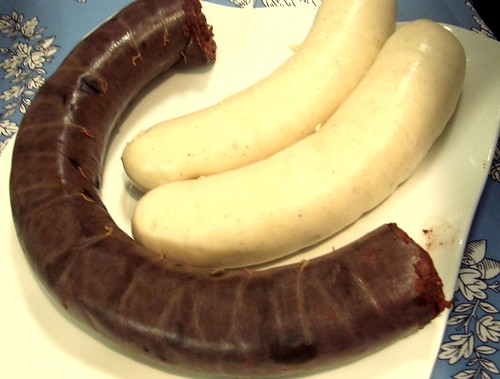
The Paris Beat is covered by our foreign correspondent Jeanlouise: Jolie
[Dear Macmac]
Here’s an oldie but goodie for the nose to tail crowd: Blood sausage, or as my French friends say, le boudin noir. Blood is pretty high up there on the squeamish scale, but with rich flavors and no funky textures, the adventurous will be rewarded for diving in mouth first. I bought my first blood sausage in March when hosting some traveling eaters from Ann Arbor. When we approached the counter, I only knew we wanted boudin noir. A piece was cut off and wrapped in paper. I asked for guidance on preparation: It was already cooked so it could be eaten cold or even better if you have the time, fry the sausage gently in butter and serve up with some cooked apples. After picking up some apples from the fruit vendor next door, we excitedly headed home and got the frying pan going. I was a bit nervous about trying the sausage. I mean, blood man, gross right? Wrong. After chomping up that sausage, I sat back reassured, satisfied and curious- what was that thing and why was it so tasty?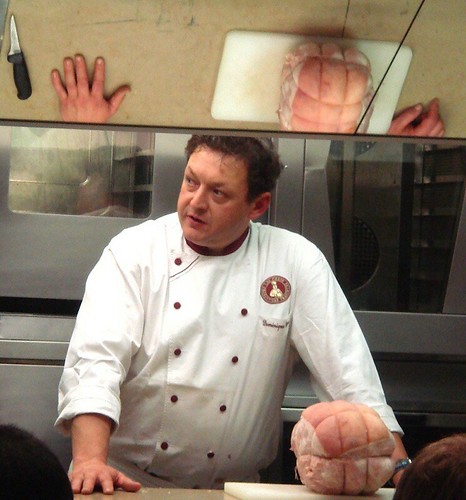
Answers came last week when master artisanal charcutier Dominique Bignon came to school for a demonstration. Monsieur Bignon has won many awards for his work including the gold medal for boudin noir in 2006 (another reason to love France: it is a country that rewards good work). He runs a shop called Au Cochon Rose (The Pink Pig) in the XVeme. He has about 10 full time workers in an on-site ‘laboratory’ where they make blood sausage every Tuesday and Friday, among many other things (terrines, pates, head cheeses, hams, rilletes, etc). 
Monsieur Bignon’s smiley demeanor won me over immediately- here was a man who loved the pig. He set to work demonstrating how to make boudin noir. The ingredients are simple: equal part of onions, jowl and blood, some cream, parsley and seasonings. The onions are chopped and cooked into a confit (softened and sweet). Then the jowl is added and cooked very gently-- or lovingly according to M. Bignon! for about 10-15 minutes, at which time the parsley is added. 
Then, then magic happens . . . .off heat, the blood is poured into the onions. Spices (salt, pepper, nutmeg and the royal boudin spice mix) are stirred in followed by the cream, which acts as a biding agent. 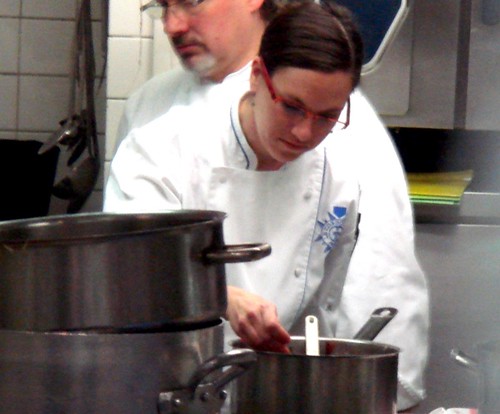
At this point, he asked if anyone wanted to try the ‘raw’ blood mixture. My hand shot up. Jokes about me being a pastry student were made. The stuffing was delicious and ready to be funneled into casings. Purists will stop here. But if you wish, you could at this point add to the stuffing cooked apples, chopped chestnuts, fatback, cabbage or what ever else you dream up. . . 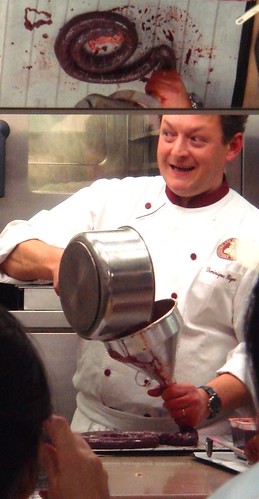
Our master charcuiter used a large metal funnel to stuff the casings. He did not knot the end to avoid air pockets, and tied off both ends once the casing was filled. 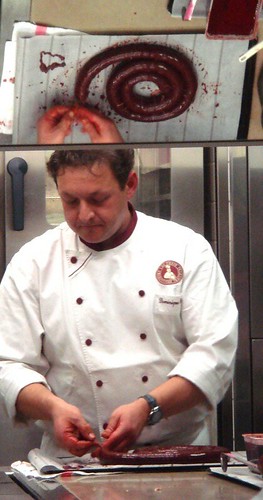
The tying he said, was the trickiest part. Anyone who has made sausage will agree. You walk the fine line between a nice plump link, and the alternative, a burst casing and blood all over your kitchen (Brown dogs will however, lap up your misfortune). 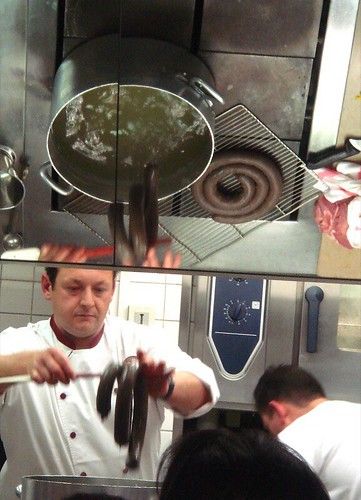
To finish off, the sausage is poached (80 c) for 15-20 min (or until it does not geyser out when pricked). The poaching water should be green, as this is an indicator of fresh blood with the principle being that the greener the water, the fresher the blood.
The freshly poached boudin was delicious, homey and incredibly rich. There were also other preparations from the Cochon Rose for us to try (a variety of head cheeses, ham, duck liver pate). The one dish that really blew me away was a variation on the boudin noir: a boudin noir terrine. 
The terrine is made from packing the base boudin noir stuffing into a greased loaf pan. In order to have a firm, sliceable loaf an additional gelling agent is required. Pig snout is the part of the animal that contains the most gelatin (feet are second). To prepare his terrines, M. Bignon will pre-cook fresh (not brined) snouts, chop them very fine and add them to base. A terrine will need to cook longer—about 1 hour in a water bath in a gentle oven. The internal temperature should reach 72 c, 65c being the magic temperature at which proteins bind properly for a nice solid terrine. The terrine that I tasted also contained pig tongue and cooked apples. Again, I was nervous. . . I mean tongue, gross right? Wrong again, so very wrong.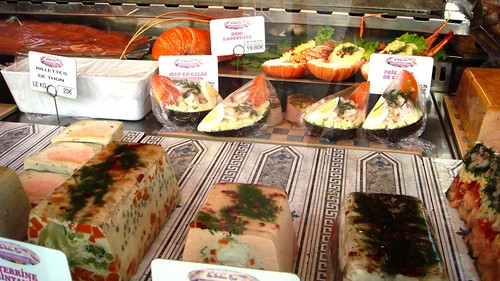
Très Bien!
Au Cochon Rose
137 RUE SAINT CHARLES
75015 PARIS
01 45 78 03 68
DU MARDI AU VENDREDI DE 9H00 A 13H30
ET DE 15H30 A 19H30
SAMEDI 8H30 A 19H30
DIMANCHE DE 8H30 A 13H00
20 April, 2009
The Paris Beat: Le Boudin Noir
Posted by mac at 09:23
Labels: Au Cochon Rose, Blood Sausage, Boudin Noir, Culinary school, Jolie, Paris Beat
Subscribe to:
Post Comments (Atom)


No comments:
Post a Comment